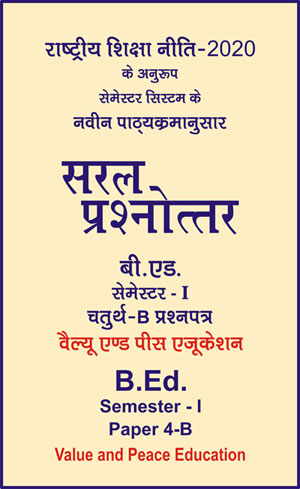|
बी एड - एम एड >> बी.एड. सेमेस्टर-1 प्रश्नपत्र-IV-B - वैल्यू एण्ड पीस एजुकेशन बी.एड. सेमेस्टर-1 प्रश्नपत्र-IV-B - वैल्यू एण्ड पीस एजुकेशनसरल प्रश्नोत्तर समूह
|
5 पाठक हैं |
||||||
बी.एड. सेमेस्टर-1 प्रश्नपत्र-IV-B - वैल्यू एण्ड पीस एजुकेशन (अंग्रेजी भाषा में)
Question- What are the consequences and result of World War-I?
Answer -
Consequences of The War
(1) Economic Consequences : World War I cost the participating countries a lot of money. Germany and Great Britain spent about 60% of the money their economy produced. Countries had to raise taxes and borrow money from their citizens. They also printed money in order to buy weapons and other things they needed for war. This led to inflation after the war.
(2) Political Consequences : World War I brought an end to four monarchies: Czar Nicholas II of Russia, Kaiser Wilhelm of Germany, Emperor Charles of Austria, and the Sultan of the Ottoman Empire had to step down.
(a) New countries were created out of old empires. Austria-Hungary was carved up into a number of independent states.
(b) Russia and Germany gave land to Poland. Countries in the Middle East were put under the control of Great Britain and France.
(c) What was left of the Ottoman Empire became Turkey.
(3) Social Consequences : World War changed society completely. Birth rates declined because millions of young men died (eight million died, millions wounded, maimed, widows, and orphans). Civilians lost their land and fled to other countries.
(a) The role of women also changed. They played a major part in replacing men in factories and offices. Many countries gave women more rights after the war had ended, including the right to vote.
(b) The upper classes lost their leading role in society. Young middle and lower class men and women demanded a say in forming their country after the war.
(4) Treaty of Versailles : On June 28, 1919, World War I officially ended with the signing of the Treaty of Versailles. The Treaty of Versailles was an attempt to prevent the world from going into another war.
However, the war also brought other important social and ideological changes :
(1) The U.S., which had won the war but had not experienced the conflict on its territory, became a first world power.
(2) The mass mobilization of men led to the incorporation of women into the workforce, which was a major step forward for women’s rights.
(3) The triumph of the Soviet Revolution (Russian Revolution) and the social crisis that followed the war encouraged workers in many countries to protest, creating a pre-revolutionary climate.
(4) The extreme nationalism experienced during the war, coupled with fear of a Communist revolution, encouraged the middle-class populations of some countries to move to the extreme right. This created a hotbed of fascist movements.
(5) Creation of the League of Nations : The League of Nations was an international diplomatic group developed after World War I as a way to solve disputes between countries before they erupted into open warfare. A precursor to the United Nations, the League achieved some victories but had a mixed record of success.
Result of World War I
(1) As many as 8.5 million soldiers and some 13 million civilians died during World War I.
(2) Four imperial dynasties collapsed as a result of the war: the Habsburgs of Austria-Hungary, the Hohenzollerns of Germany, the sultanate of the Ottoman Empire, and the Romanovs of Russia.
(3) The mass movement of soldiers and refugees helped spread one of the world’s deadliest influenza pandemics, also called the Spanish flu.
(4) The map of Europe changed forever as territories were divided among the victorious Allied powers.
(5) The war led to the October Revolution in Russia, which put the Bolsheviks in power of the Russian government.
(6) The United States emerged as a world power.
(7) Chemical weapons, such as mustard gas and phosgene, and new technologies and developments, such as machine guns, tanks, and aerial combat, were introduced. A protocol signed at the 1925 Geneva Conference for the Supervision of the International Traffic in Arms restricted the use of chemical and biological agents in warfare.
(8) Growth of nationalism in central and eastern Europe set the foundation for World War II.
|
|||||













